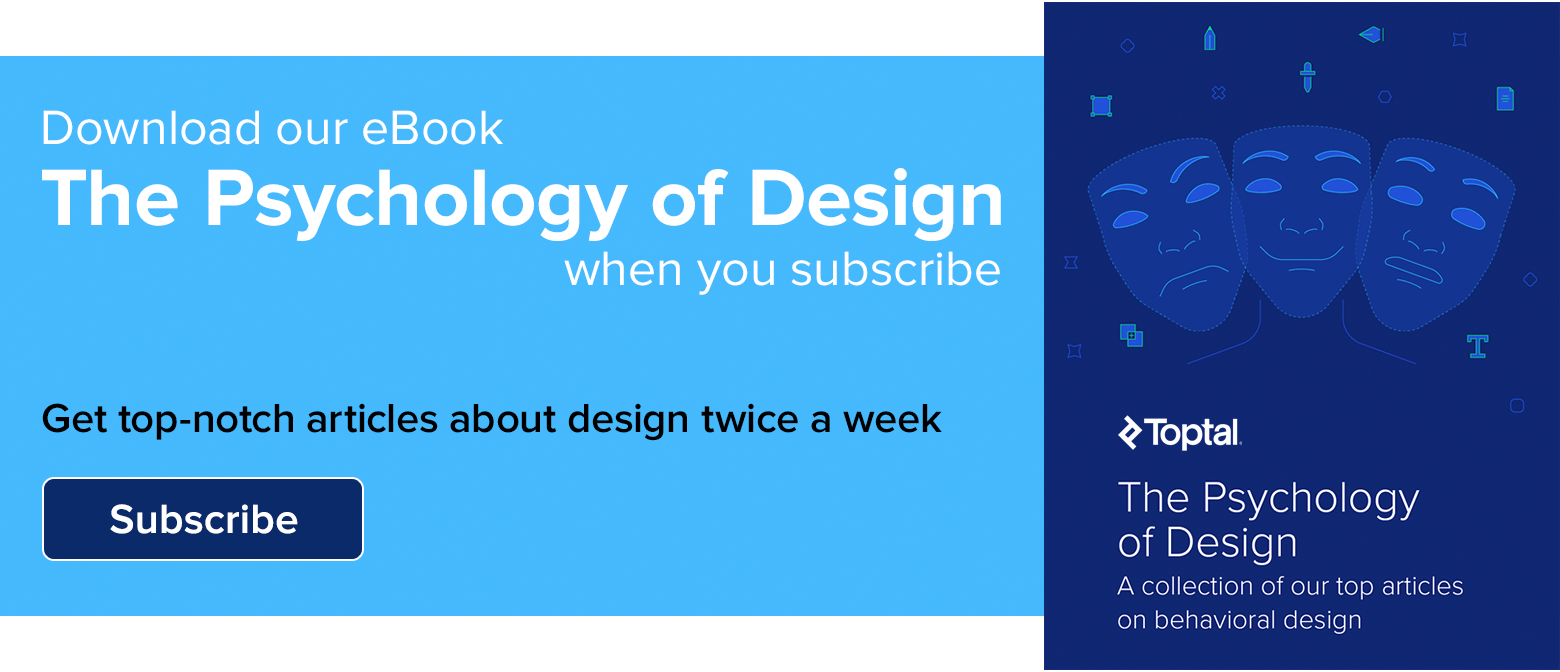Design Constraints Are Not Restraints, They Stoke Creativity
Design constraints are clues. They help designers triangulate between the problems, resources, and criteria inherent in every project and prevent precious time wasted on extraneous design ideas.
Design constraints are clues. They help designers triangulate between the problems, resources, and criteria inherent in every project and prevent precious time wasted on extraneous design ideas.
Micah helps businesses craft meaningful engagement through branding, illustration, and design.
Expertise
Every design endeavor, whether a one-off banner ad or a multichannel marketing campaign, is bound by factors that limit creative decision-making. These binding factors are called design constraints. Though they might seem to undermine originality, constraints are keys to unlocking long-term design solutions.
Constraints are design limitations. An obvious example is budget. Money affords manpower, tools, and to some extent, time. Other factors, like governing bodies and public opinion, are harder to buy. And of course, no design solution supersedes the laws of nature.
Viewed unfavorably, constraints are a form of deprivation. They are unavailable options and mandates that exclude “better” alternatives. The connotation is wholly negative. Constraints stifle creativity.
Viewed differently, constraints are ingenuity enhancers. Because resources aren’t inexhaustible and design criteria must be met, constraints force a more methodical analysis of people and their problems. They push designers to be strategic about the processes they use and energies they expend.

Design Constraints Aren’t Restraints
In artistic undertakings, constraints solve the blank canvas problem. An infinite universe of options overwhelms the first stroke. Constraints embolden the brush by intentionally forsaking creative choices (like color or subject matter). Decision-making is swift and simple as seemingly one-dimensional actions accumulate greater levels of sophistication.
The same power is available to designers, but the client/designer dynamic adds a psychological stigma that’s less common in the art world. In the designer’s mind, client-requested constraints undergo a strange metamorphosis. They become restraints, locked gates preventing access to ideal design outcomes.
It’s an unproductive outlook, one that leads designers to make faulty assumptions clients don’t intend. While pining for creative freedom, obvious opportunities are missed.

Design briefs with specifications and constraints aren’t closed doors. They’re signposts from which designers may boldly embark on problem-solving investigations.
What types of design constraints should designers be aware of? More importantly, why do these constraints exist and how are they leveraged for design innovation?
9 Constraints Every Designer Should Know
There are endless ways to impose limits on design. For clarity, it’s helpful to identify design brief specifications and constraints, and their examples, by using categories. Some are well-known, others unexpected.
1. Commercial Constraints
Commercial constraints are linked to business resources like time, budget, and manpower. In design projects, commercial constraints are weighed against each other. When clients compose briefs, commercial constraints are prominently featured. “We need X deliverable, in Y amount of time, for Z cost.”
Commercial constraints aren’t immutable laws. Asking clients why they exist might lead to more time or budget, or it may reveal a need for design deliverables that clients hadn’t considered.
2. Compliance Constraints
Depending on the project, there may be laws, standards, or regulations that designers must adhere to:
- Packaging and label requirements
- Data privacy rules
- Accessibility mandates for digital and physical environments
The list is ever lengthening.
When designers encounter new or unfamiliar compliance constraints, it’s tempting to turn to online research to avoid “losing face” with clients. Independent research is helpful but insufficient. Clients have vast industry knowledge, and most will happily share:
- Why the constraints exist in the first place
- How the constraints are typically addressed or if there are varying interpretations
- Ideas for improving the constraints’ design impact

3. Functional Constraints
Every design brief outlines required features or functionalities:
- Body copy for a marketing one-pager
- Icons for a SaaS platform
- Product photos for a retail display
It’s unwise to think of functional constraints like items on a checklist. The client asks for it. The designer does it. ✓Check. Here, the designer is merely an extension of the client’s creative faculties–like a marionette.
A better way? Ask why features and functionalities are needed before projects begin. Doing so may reveal that clients aren’t strongly tied to certain requests, thus allowing designers to suggest alternative solutions when appropriate.
4. Non-functional Constraints
Non-functional constraints relate to qualities that designs should possess–words like simple, fast, easy-to-use, and affordable are common.
Here again, it’s critical to understand the rationale behind clients’ inclusion of such descriptors. Sometimes, clients draw unrealistic comparisons between real-world examples and the attributes they want designs to have.
For instance, if a client wants their banking app to be simple and mentions a note taking app as the benchmark, it’s the designer’s job to clarify the parallels the client is trying to make and point out discrepancies when correlations aren’t logical.

5. Sensory Constraints
Sensory considerations are massively overlooked in contemporary design, especially digital design, where so much emphasis is placed on sight. It’s rare to encounter sensory constraints in creative briefs, but by refusing to engage or even think about senses beyond sight, designers do themselves and their clients a disservice.
In years to come, sensory design will flourish as more companies look to transition experiences away from screens by integrating technology into wearables and the built environment–where sounds, smells, tastes, and textures exist in abundance.

6. Stylistic Constraints
Stylistic constraints are rooted in aesthetic qualities and are typically shared in brand style guides, component libraries, or other documents used for design decisions. Sometimes, clients blur the line between stylistic and non-functional constraints by asking designs to embody open-ended words (e.g., fun, dynamic, compassionate, etc.).
Ultimately, designers need to ask for context. Why do stylistic constraints exist and what are they meant to communicate? In this way, designers are empowered to take action when creative decisions (inevitably) pose problems not outlined in style documents.

7. Systems Constraints
Systems constraints have to do with how a new or updated design fits into an overall system of design considerations. For example, how does a UI update impact a website’s:
- Back end?
- Navigation?
- Conversion rate?
Be warned. On one hand, there are clients who are acutely aware of systems constraints and seek assurance that new designs won’t adversely impact existing systems. On the other hand, there are clients who don’t realize that the design changes they want will be disruptive.
In either case, it’s best for designers to be forthright about potential issues. Don’t give ungrounded guarantees. Design updates come with an inherent level of risk.
8. Self-imposed Constraints
Self-imposed constraints govern creative decision-making. Some designers follow rigorous design methods, while others limit tool choices or stylistic options. Fine artists like Yayoi Kusama and Robert Smithson employ self-imposed constraints to dramatic effect.
As with any strategy, designers ought to ask themselves why they’ve chosen self-imposed constraints:
- Do the constraints somehow link to project learnings or enhance problem-solving capacity?
- Will they yield design solutions that delight users or provide clients with marketing advantages?
- Or are they simply a way to stimulate creativity and overcome the proverbial blank canvas?

9. Skill Level Constraints
By default, design projects involve designers. The abilities of those designers are constraints. This is especially true of projects where designers are asked to perform roles across multiple disciplines. It also occurs when a client’s budget calls for less experienced designers.
Obviously, it can be tricky to address professional shortcomings. Designers don’t want to feel inadequate, and clients don’t want to be short-changed. Approached tactfully, skill level constraints may be used to convince clients to hire additional design support, or they can open opportunities for designers to develop new abilities.
Embrace Design Constraints
Constraints are clues. They help designers triangulate between the problems, resources, and criteria inherent in every project and prevent precious time wasted on extraneous design ideas. When constraints are only seen as restraints, opportunities for innovation remain unearthed, often inches beneath the surface.
In a profession that encourages boundaries to be pushed, embracing constraints isn’t glamorous, but it does lead to relevant design solutions with long-term staying power.
Let us know what you think! Please leave your thoughts, comments, and feedback below.
Further Reading on the Toptal Blog:
Understanding the basics
What are constraints in a design brief?
There are many types of design constraints. For instance, commercial constraints include considerations like time, budget, and manpower. Stylistic constraints, often shared in brand guides, limit designers aesthetic choices. In some cases, compliance constraints ensure designs align with laws and regulations.
What is an example of a constraint?
Design constraints are limits placed on design. An obvious example is budget. Another is screen size. A less obvious design constraint example is a designer’s skill level. Skill constraints are especially pressing when a single designer is responsible for deliverables in multiple disciplines (UI, UX, illustration, brand, etc.).
What are design requirements and constraints?
Clients hire designers to fulfill design-related needs. These needs are linked to constraints, or design limitations, like budget, deliverables, and style expectations. Some constraints, like project timeline, are flexible. Others, like regulatory mandates, are more rigid.
What are design constraints?
Design constraints are limitations that force a more methodical analysis of people and their problems. Because resources aren’t inexhaustible and criteria must be met, they push designers to be strategic about the processes they use and energies they expend.
Micah Bowers
Vancouver, WA, United States
Member since January 3, 2016
About the author
Micah helps businesses craft meaningful engagement through branding, illustration, and design.


